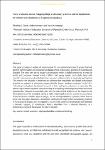‘Grey’ exclusions matter: Mapping illegal exclusionary practices and the implications for children with disabilities in England and Australia
| dc.contributor.author | Done, Elizabeth | |
| dc.contributor.author | Knowler, H | |
| dc.contributor.author | Armstrong, D | |
| dc.date.accessioned | 2021-08-18T18:12:42Z | |
| dc.date.issued | 2021-08-24 | |
| dc.identifier.issn | 1471-3802 | |
| dc.identifier.issn | 1471-3802 | |
| dc.identifier.uri | http://hdl.handle.net/10026.1/17609 | |
| dc.description | File replaced (docx to pdf) on 28/4/23 by NK | |
| dc.description.abstract |
<jats:p>This paper provides an outline of, and rationale for, an international research project that will identify commonalities and disparities in illegal school exclusionary practices in Australia and England. The aims here are to situate such practices within a global context and to map the events and processes through which children and young people, particularly those with ‘special’ educational needs and disabilities, are removed from school in Australia and England. The research we advocate is premised on evidence that inequitable and illegal exclusionary practices are endemic in education systems globally; hence, ‘pushout syndrome’ in the USA, ‘off rolling’ in England, facilitated ‘dropout’ in Italy and ‘grey exclusions’ in Australia. The authors argue that the repeated commissioning of research by national governments and school inspectorates, intended to accurately ascertain the scale of this problem and its impact on the life trajectories of the excluded, serves to defer meaningful action to prevent its occurrence. School exclusion, whether legal or illegal, can be conceptualized as a process rather than an event, and this paper discusses a descriptive continuum through which exclusionary practices in Australia and England can be mapped An experiential continuum is proposed that facilitates a thematic mapping of contributory factors, identified from a relevant literature, as a preliminary analytical framework for future research.</jats:p> | |
| dc.format.extent | 36-44 | |
| dc.language | en | |
| dc.language.iso | en | |
| dc.publisher | Wiley | |
| dc.title | ‘Grey’ exclusions matter: Mapping illegal exclusionary practices and the implications for children with disabilities in England and Australia | |
| dc.type | journal-article | |
| dc.type | Journal Article | |
| plymouth.issue | S1 | |
| plymouth.volume | 21 | |
| plymouth.publication-status | Published | |
| plymouth.journal | The Journal of Research in Special Educational Needs | |
| dc.identifier.doi | 10.1111/1471-3802.12539 | |
| plymouth.organisational-group | /Plymouth | |
| plymouth.organisational-group | /Plymouth/Faculty of Arts, Humanities and Business | |
| plymouth.organisational-group | /Plymouth/Faculty of Arts, Humanities and Business/Plymouth Institute of Education | |
| plymouth.organisational-group | /Plymouth/REF 2021 Researchers by UoA | |
| plymouth.organisational-group | /Plymouth/REF 2021 Researchers by UoA/UoA23 Education | |
| plymouth.organisational-group | /Plymouth/Users by role | |
| plymouth.organisational-group | /Plymouth/Users by role/Academics | |
| dcterms.dateAccepted | 2021-08-16 | |
| dc.rights.embargodate | 2023-8-24 | |
| dc.identifier.eissn | 1471-3802 | |
| dc.rights.embargoperiod | Not known | |
| rioxxterms.versionofrecord | 10.1111/1471-3802.12539 | |
| rioxxterms.licenseref.uri | http://www.rioxx.net/licenses/all-rights-reserved | |
| rioxxterms.licenseref.startdate | 2021-08-24 | |
| rioxxterms.type | Journal Article/Review |


